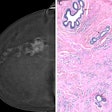The fourth edition of BI-RADS includes guidelines on the quantitative assessment of breast tissue. The categories range from breast tissue that is less than 25% glandular to tissue that is more than 75% glandular. The goal with quantitative assessment is to more precisely mark differences in breast density, according to a multi-institutional group writing in Radiology. They compared a fully automated mammographic density estimation (MDEST) program with BI-RADS and radiologists' estimation of breast density.
"With use of quantitative percent breast density determinations, one is more likely to detect subtle changes in breast density that may be masked when they are classified in the same BI-RADS category as the overall breast density," wrote lead author Dr. Katherine Martin from Associated Radiologists Limited in Mesa, AZ. Martin's co-investigators are from the University of Michigan Health Center in Ann Arbor and the University of Pennsylvania School of Medicine in Philadelphia (Radiology online, July 20, 2006).
For this retrospective study, the dataset consisted of 244 mammograms (craniocaudal and mediolateral oblique views) in 65 patients with a mean age of 53. The MDEST analysis used gradient-based edge-tracking algorithms to detect breast edge, crop the pectoral muscle, and estimate gray-level threshold for density segmentation.
The dataset was also read by seven radiologists, five of whom were familiar with how the MDEST program worked. They performed qualitative BI-RADS density classification, a quantitative estimate of density percentage, and determined the reference-standard density.
According to the results, there was a close correlation between the reference standard and radiologist-estimated density (R = 0.90-0.95) and MDEST density (R = 0.089). The authors also reported that MDEST correlated better with percentage density than with qualitative BI-RADS categories, as there was a significant overlap in percentage density in BI-RADS categories 2-4. Qualitative BI-RADS categories correlated poorly with the new quantitative categories, they stated.
Finally, the untrained radiologists overestimated percentage density by an average of 37% compared with 6% of the radiologists who were trained in MDEST.
"Our results show that experienced radiologists' subjective density assessments based on qualitative BI-RADS categories may be quite different from density assessments based on quantitative BI-RADS categories," they wrote. "The MDEST breast density determinations were more accurate than the radiologists' visual estimates of breast density.... The MDEST program overestimated density by a mean of only 1%."
This study did have some limitations, including MDEST technical errors. Also, the authors acknowledged that volume, rather than density, would be a more accurate measure of breast tissue. Additional studies are needed to determine if quantitative evaluation of tissue volume can improve the correlation between density and cancer risk.
By Shalmali Pal
AuntMinnie.com staff writer
July 31, 2006
Related Reading
Expanded role looms for 3D in breast imaging, April 11, 2006
MRI continues to make headway in breast cancer imaging, October 28, 2005
HRT increases breast density on mammography, October 3, 2005
Copyright © 2006 AuntMinnie.com



















